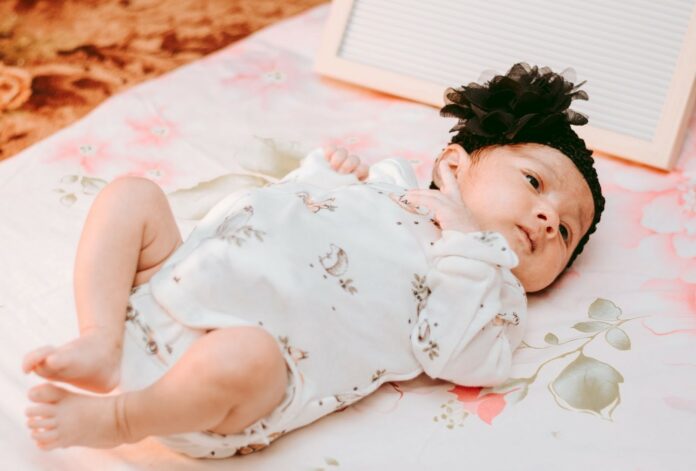Expectant mamas usually take classes to learn how to change a diaper, soothe Baby when they seem to be inconsolable, and give Baby a bath. They’ll likely have resources to troubleshoot breast- or bottle-feeding. But, as Dr. Hassan Alzein of Alzein Pediatrics in Evergreen Park and Oak Lawn knows, “No matter how well-prepared new parents are, there is always something new to learn.” Dr. Alzein says, “We hear many questions about baby care in the first few weeks after the Baby arrives, but there are six common topics we most frequently address.”
1. Cleaning Your Baby’s Genitals
“Many mothers are concerned about properly cleaning the diaper area and about the differences in hygiene for boys and for girls. To clean your baby’s genitals, when bathing, use a soft, clean cloth, gentle soap, and lukewarm water,” says Dr. Alzein. When you have a girl, wash the genital area from front to back, to avoid moving bacteria into the vaginal area, and gently wipe between skin folds. If you have a baby boy who’s been circumcised and his incision has healed, simply wipe his penis clean. If your baby boy is uncircumcised, do not pull back the foreskin as this can cause tears, infection and bleeding. Carefully wipe Baby’s buttocks with a cloth and gentle soap. When changing diapers, be sure to use gentle and unscented wipes.
2. Baby Poop
A baby’s first few bowel movements will be a dark green, tar-like goo with hardly any smell. “This is called meconium and is the first stool expelled by your newborn,” Dr. Alzein says.“It’s also common to find mucus in a newborn’s bowel movement. If you breastfeed your baby, the poop may look yellow and runny, with a consistency like mustard. If you feed with formula, the poop may be tan and pasty, looking like peanut butter.” When Baby starts eating solid foods, bowel movements will have a foul odor and be all different kinds of colors, depending upon what foods your child has eaten.
“While very rare, certain colors of stool can be a sign of a possible health issue,” says Dr. Alzein. “Always check in with your pediatrician if your baby’s stool is any unusual colors.”
- Red. “There are lots of common and harmless reasons for red bowel movements,” says Dr. Alzein. “A newborn baby may have swallowed a little blood during delivery. When you’re breastfeeding, it might be that your nipples are bleeding, and blood has mingled with breast milk. If your little one is eating solids, it could be a certain food, such as beets, coloring making poop red. But always – always – check with your pediatrician when you see bright red stool as it’s important to determine what might be causing it.
- Black or dark green. Tarry black stool in older babies could, in some cases, be caused by blood, which may turn from red to black inside the intestines over time. “Very dark green stool can sometimes appear black,” says Dr. Alzein. Green baby poop—even a dark green is usually nothing to worry about. Meconium can also look black, and this isn’t a problem. “Call your pediatrician if this suddenly appears, or doesn’t go away in a few bowel movements.”
- White or gray. “Call your pediatrician immediately if you see very pale white or clay-colored stools in your baby’s diaper. It could be a sign of a liver or enzyme condition that needs prompt diagnosis and treatment,” says Dr. Alzein.
3. Cutting Baby’s Nails
Dr. Alzein says, “Your newborn’s fingernails grow so quickly that you may have to trim them more than once a week to avoid them scratching their face – or yours. Toenails grow more slowly, so they won’t need shortening as often.”
It is easier to cut your newborn’s nails if two people are involved. One adult should gently hold the baby, while the other trims their nails. If your baby is very active, or you do not have another adult present, try cutting nails while the baby is feeding or sleeping.
Press Baby’s finger pad away from the nail to avoid nicking the skin, and keep a firm hold on their hand as you cut or clip. Cut the nail around the curve of the finger, and trim the toenails straight across.“If you accidentally nick the skin, don’t feel bad,” says Dr. Alzein. “This is a difficult skill to master.” Gently hold a piece of clean, damp cotton wool to the fingertip and apply pressure. The bleeding will soon stop. Don’t put a bandage on the cut, as this is a choking hazard.
“When your baby is about a month old, their nails will have started to harden a little and will have a firmer free edge,” says Dr. Alzein. “This will make it easier to trim them using baby nail scissors or clippers with rounded ends, though you’ll still need to do this carefully. Using nail files made specifically for infants can make this job easier.”
4. Cradle Cap
“Cradle cap commonly appears in skin folds near the neck, behind the ears, or on the top of the head,” says Dr. Alzein. “It is typically yellowish with greasy patches, or is scaly or flaky.”
“The skin condition can show up in other places on your baby’s body, such as the face, on the ears, eyelids, eyebrows, and nose, or on the body on the neck, armpit, belly button, legs, and groin,” says Dr. Alzein. “The good news is cradle cap isn’t contagious, and it generally isn’t painful or itchy and it doesn’t scar.”
“It’s likely to clear up on its own within weeks or months, and almost certainly by the time Baby is 12 months old. Cradle cap doesn’t usually require any specialized medical treatment. You can usually treat it yourself at home and help remove the scaling skin.”
- Wash your baby’s hair frequently, even daily, with a mild, unscented baby shampoo.
- Gently comb any hair and brush over the scales with a soft bristle brush to loosen the flakes of skin. Don’t scratch or rub the skin affected by cradle cap. Wash loose flakes away with water.
“If these treatments don’t improve cradle cap, ask your pediatrician to recommend a medicated shampoo.”
5. Baby Acne
Dr. Alzein says, “Your newborn baby may suddenly develop small pimples on their face, usually on their cheeks, nose, eyelids, chin, or forehead. This is baby acne or neonatal acne. It’s common in newborns; 3 out of 10 babies will develop it. Sometimes the acne can also appear on your baby’s scalp or on their neck or upper trunk. Unlike acne that teens and adults can experience, baby acne does not have blackheads or whiteheads,” says Dr. Alzein.
“There are no methods to treat baby acne as it resolves by itself within a few months. However, there are a few things you can do to lessen the severity or unpleasantness of baby acne.”
- Ensure that your baby’s bed sheets and clothing are washed in detergent made for sensitive skin or for infants.
- Gently wash your little one’s face every day with warm water and pat it dry. Avoid pinching or scrubbing the pimples as this can cause an infection and scarring.
6. Ear Infections
“There are few things more stressful than when your infant has pain and can’t tell you why. Ear be unnerving,” says Dr. Alzein.
The signs your child could have an ear infection include:
- Tugging or pulling the ear
- Crying and irritability
- Difficulty sleeping
- Fever, especially in younger children
- Fluid draining from the ear
- Difficulty hearing or responding to auditory cues
The most common type of ear infection occurs when fluid builds up behind the eardrum, infecting and causing swelling to parts of the middle ear. Treatment is relatively straightforward.
“When your baby is 6 months or younger, antibiotics may be recommended because your infant’s immune system is not yet strong enough to fight the infection. From six months to two years old, your pediatrician should recommend a wait-and-see approach for several days, because the infection is likely to clear up without medical help. If the ear infection lasts longer than a few days, antibiotics may be the next course of action. When Baby is over two years old, your doctor will likely recommend over-the-counter medications like ibuprofen or acetaminophen to relieve the pain,” says Dr. Alzein.
If your child has chronic recurring infections or a very long-running infection, says Dr. Alzein, your doctor may recommend a procedure to put tubes in your child’s ear to improve airflow and prevent fluid buildup. “The tubes are about the size of a piece of rice and usually fall out on their own after 6 months. It is a very common procedure that helps thousands of kids each year avoid the pain, complications and possible hearing loss of ear infections.”
Dr. Alzein says, “Don’t ever hesitate to call your pediatrician when you have questions about your child’s health. We are always happy to address your concerns – be it oddly colored poop to pain and discomfort. Your pediatrician will give you evidence-based answers and techniques to help your growing child.”

















